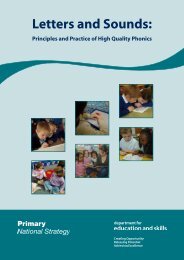Letters and Sounds: Appendices
Letters and Sounds: Appendices
Letters and Sounds: Appendices
You also want an ePaper? Increase the reach of your titles
YUMPU automatically turns print PDFs into web optimized ePapers that Google loves.
Assessment tasks<br />
(See the section on assessment in the Notes of Guidance for Practitioners <strong>and</strong> Teachers,<br />
page 16.)<br />
Contents<br />
■<br />
■<br />
■<br />
■<br />
Grapheme–phoneme correspondences task<br />
Oral blending task<br />
Oral segmentation task<br />
Non-word reading task<br />
Grapheme–phoneme correspondences task<br />
s, a, t, p, i, n<br />
<strong>Letters</strong> <strong>and</strong> <strong>Sounds</strong>: <strong>Appendices</strong><br />
Securing success from the start for all beginner readers is an obvious but crucially<br />
important aim of the <strong>Letters</strong> <strong>and</strong> <strong>Sounds</strong> programme. The first six letters children will learn<br />
to read <strong>and</strong> write at the start of the systematic teaching of phonics in Phase Two are s,<br />
a, t, p, i, n. Once learned, these letters provide children with an easy, but very useful, set<br />
of phoneme–grapheme correspondences with which to build two-letter <strong>and</strong> three-letter<br />
words.<br />
Purpose<br />
■<br />
To assess knowledge of grapheme–phoneme correspondences<br />
Resources<br />
■<br />
Grapheme card (see the example below)<br />
■<br />
Group assessment sheet with the names of the children entered (see the example on<br />
page 201–202)<br />
00281-2007BKT-EN<br />
© Crown copyright 2007<br />
<strong>Letters</strong> <strong>and</strong> <strong>Sounds</strong>: Principles <strong>and</strong> Practice of High Quality Phonics<br />
Primary National Strategy<br />
199
















